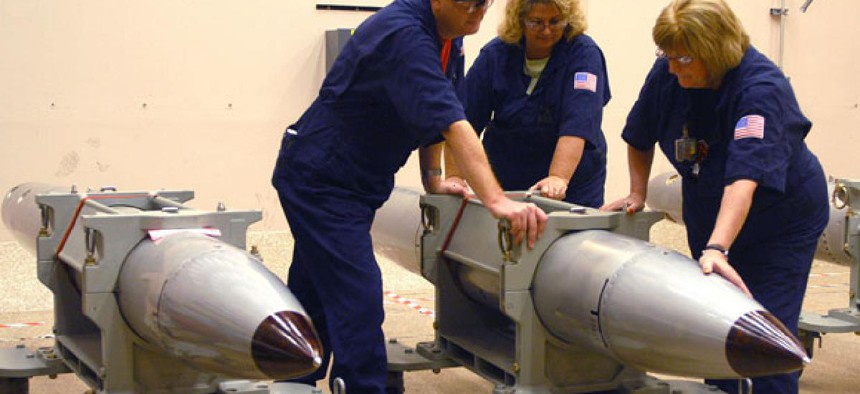Aging technology endangers Pantex security, auditors warn

Technicians at the Pantex Plant in Texas ready a B-61 nuclear gravity bomb for a 2007 surveillance test. National Nuclear Security Administration
Energy Department IG says plant's security system could malfunction if it does not receive maintenance.
A deteriorating nuclear-weapon security system at the Pantex Plant in Texas could malfunction if it does not receive maintenance, the U.S. Energy Department inspector general warned in a report made public on Friday.
The technology had a projected "useful life" of two decades upon entering use in the 1990s and it is now in need of sustainment updates, an insider with a branch of the National Nuclear Security Administration, which oversees U.S. nuclear weapons complex operations, told DOE auditors.
The facility near Amarillo switches out or fixes components in certain nuclear arms, and it carries out disassembly of weapons retired from the atomic arsenal. The protective apparatus is specifically designed to protect "Zone 4W," the sole area of the Texas plant involved in short-term storage of atomic armaments and "other nuclear explosive assembles," according to the Jan. 29 assessment.
Any failure in the defenses would necessitate the use of "compensatory measures" to shore up protections, according to NNSA and Pantex personnel. No details on the system are publicly available, and the IG report does not specify what security vulnerability could arise from any malfunction.
Existing regulations permit employment of stopgap protections, but overuse of such measures contributed to failures revealed in a July break-in at the Y-12 National Security Complex in Tennessee, DOE auditors said, citing previous findings.
The National Nuclear Security Administration has called for Pantex personnel to develop a proposal to "upgrade or replace" the Zone 4W security system, insiders with both organizations told auditors. Neither the National Nuclear Security Administration nor the plant's contract operator responded by press time to requests for further details.
The Texas facility is now operated by contractor B&W Pantex, a conglomerate managed by the firms Babcock & Wilcox, Bechtel National and Honeywell. A separate consortium of four private contractors is set to take over security and management of the Pantex and Y-12 sites on May 1.
Inspectors said the National Nuclear Security Administration "recognizes the potential security concern posed by the aging security system." Still, the agency as of November had not endorsed a "mission need statement" submitted three months earlier by Pantex personnel, they added; the Energy Department requires such statements in an effort to adhere to project time lines as well as cost and performance goals.
Separately, DOE investigators voiced concern over the dilapidated status of a number of nuclear-material holding structures at the Pantex Plant, but one site worker said delays in repairs to the buildings would pose no risk of accidents or security lapses.
The storage area is filled to roughly 86 percent of its capacity, the report states. A Pantex source told IG officials that the plant does not anticipate a space shortfall based on the average rate of eliminating unneeded parts, but the insider could not provide records to support the assertion.
The report also commends the Pantex Plant for surpassing its fiscal 2010 weapon disassembly goal by 26 percent and its fiscal 2011 dismantlement quota by 11 percent. The United States does not disclose the specific quantities of weapons it eliminates.
NEXT STORY: Showcasing the best government data sources





